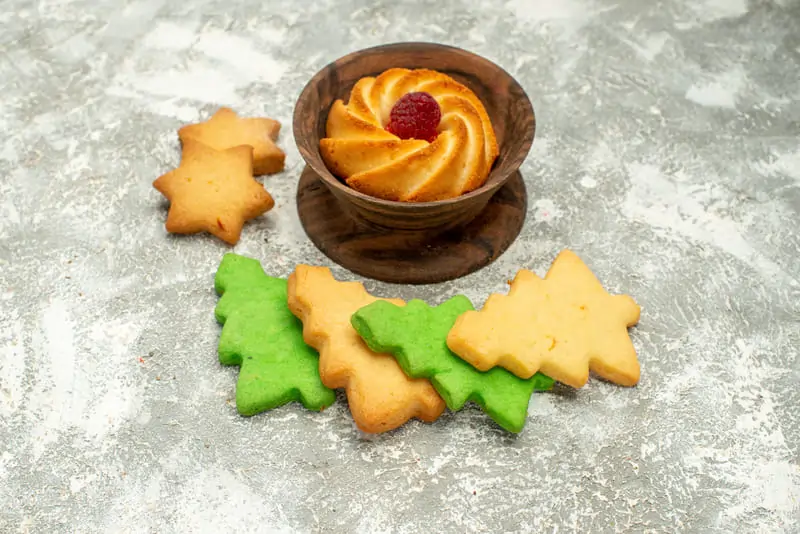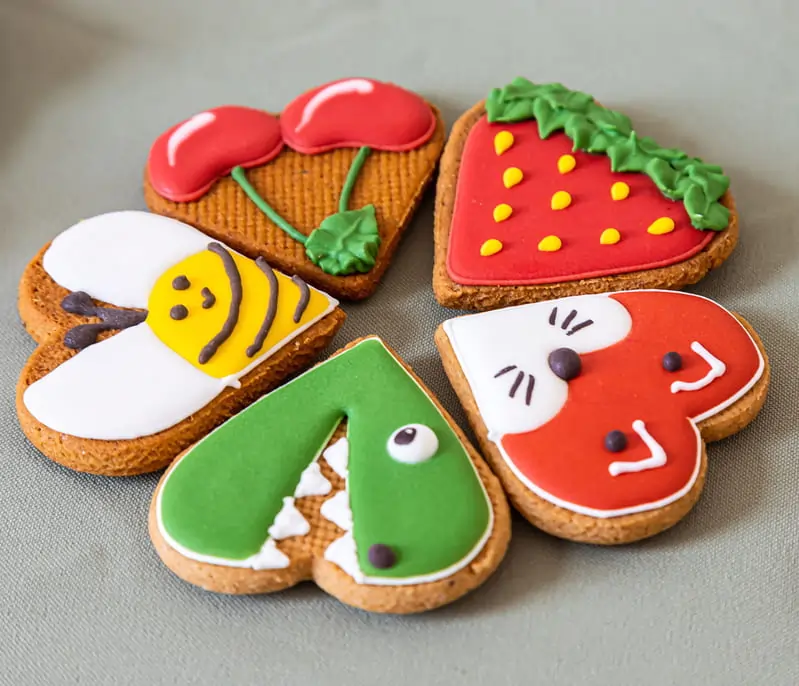Creating colorful cookies is a delightful way to make your treats stand out. Whether you’re baking for a festive occasion, a themed party, or simply adding a personal touch, learning how to color cookies opens up a world of creativity. From natural ingredients to artificial food dyes, there are numerous methods to achieve vibrant and eye-catching results.
For those looking to explore eco-friendly and innovative ideas, check out this guide on colorful ingredients in cookies. Alternatively, artificial dyes can offer precision and consistency, making them ideal for professional decorators.
Understanding the Science of Cookie Color
The art of cookie coloring extends beyond simple aesthetics; it involves understanding the complex interplay between heat, ingredients, and baking techniques. This section will delve into how these factors affect the vibrancy and appearance of colors in cookies, highlighting the role of ingredient pH levels and the impact of heat during baking. Additionally, for more in-depth guidance on baking challenges, consider exploring the topic of troubleshooting common baking issues.
Impact of Heat on Cookie Colors
Heat plays a crucial role in how colors develop and endure throughout the baking process. During baking, heat can cause natural colors to change in unexpected ways:
- Natural Colors: Ingredients like fruits, vegetables, and spices can lose their intensity when exposed to high temperatures. For example, the vibrant red of beet juice might darken or brown when baked.
- Artificial Colors: These are generally more heat-stable, but some shades might still change depending on the type of dye and its interaction with other ingredients.
Using the correct temperature and baking time is essential to minimize these effects and maintain color vibrancy as much as possible.
Influence of pH Levels on Cookie Colors
The pH level of ingredients can significantly affect the final color of your cookies. This is because certain colors react to acidic or alkaline environments:
- Acidic Ingredients: Ingredients like lemon juice or cream of tartar can brighten and preserve the red and pink tones from fruits like strawberries and raspberries. They help maintain the pH balance that favors these hues.
- Alkaline Ingredients: Baking soda, which is alkaline, can cause some natural colors to fade or change. For example, purple from blueberries may turn more blueish or greenish under alkaline conditions.
To control the effects of pH on your cookie colors, consider adjusting the amounts of acidic or alkaline ingredients, or using buffers like cornstarch to stabilize the pH level.
Techniques for Enhancing and Preserving Color
Here are some strategies to enhance and preserve the color in your cookies:
- Pre-bake Treatments: Coating fruit pieces in flour or using a light syrup glaze can help preserve their color during baking.
- Post-bake Enhancements: Applying a simple glaze or dusting with colored powdered sugar after baking can boost the visual appeal and add a layer of color.
For a deeper understanding of how to address and rectify common baking problems that might affect your cookie’s appearance, you can visit our guide on troubleshooting common baking issues. This resource offers practical tips and solutions to help you overcome obstacles like uneven baking, color loss, and ingredient interactions that could impact your baking results.
Check out creative ways to incorporate vibrant ingredients to inspire your cookie designs.
Popular Methods for Coloring Cookies
Coloring cookies is a creative endeavor that enhances their visual appeal while sometimes adding subtle flavors and additional nutrients. This article explores three popular methods for adding color to your cookies, from natural sources to artificial dyes and decorative additions. Each method provides unique benefits depending on your baking goals and the specific effects you’re aiming for. For more detailed ideas, consider exploring our guide to simple and colorful cookie recipes.
1. Natural Ingredients for Vibrant Colors

Using natural ingredients for coloring is a health-conscious choice that imparts both vibrant hues and additional flavors to your cookies. Here are some popular natural colorants:
- Fruits:
- Beet Juice: Offers a rich red color, perfect for Valentine’s Day or Christmas cookies.
- Blueberries: Crushed or juiced, they provide a natural purple tint.
- Vegetables:
- Spinach Powder: Delivers a bright green shade, ideal for creating themed cookies like shamrocks or trees.
- Carrot Juice: Produces a warm orange, suitable for autumn-themed treats.
- Spices:
- Turmeric: Known for its vibrant yellow hue, it’s great for sun-shaped or spring-themed cookies.
- Cocoa Powder: Provides a deep brown, excellent for chocolatey cookies or earth-toned designs.
Pro Tip: Enhance the flavor of naturally colored cookies by adding complementary extracts, such as vanilla or almond, which can help balance and enrich the overall taste. For additional creative ideas, delve into our guide to simple and colorful recipes.
2. Artificial Food Coloring
For bakers seeking consistent and bold colors, especially for detailed and intricate designs, artificial food colorings are a reliable choice. They come in various forms, making them adaptable for any decorating project.
- Usage Tips:
- Start with a small amount of dye and gradually increase to achieve the desired intensity without oversaturating.
- Opt for gel or powder forms when you need vibrant hues that won’t alter the consistency of your dough.
Artificial dyes are particularly useful when precision and intensity are necessary, ensuring that each cookie turns out as vibrant as planned.
3. Decorative Additions
If you prefer not to alter the dough itself, decorative additions can provide color and texture with minimal effort:
- Sprinkles: A quick and easy option for adding a burst of color and fun to any cookie, ideal for birthdays or celebrations.
- Edible Glitter: Perfect for adding a touch of sparkle and magic, especially for holiday cookies or special occasions.
- Candy-Coated Chocolates: These add both color and a pleasing texture contrast, making your cookies both tasty and attractive.
Pro Tip: Combine various decorative elements to enhance the visual appeal of your cookies. Mixing textures and colors can create a festive and enticing look that makes your treats stand out.
Techniques for Applying Cookie Color

Applying color to cookies can be as much an art as it is a culinary science. Two effective techniques that bakers often use to achieve visually stunning results are marbling and layering, as well as decorating with royal icing. Each method offers a unique way to add artistic flair to your cookies. For further inspiration, explore various ways to incorporate vibrant ingredients into your cookie designs.
1. Marbling and Layering
Marbling and layering are techniques that allow you to create artistic effects with color within the cookie dough itself. Here’s a closer look at how to implement these methods:
- Marbling:
- To achieve a marbled effect, prepare two or more colors of dough.
- Gently swirl these doughs together, using a knife or a skewer. Be careful not to overmix; you want to maintain distinct streaks of color.
- Roll out and cut your cookies from this multicolored dough to produce a beautiful marbled pattern on each cookie.
- Layering:
- Start by rolling out sheets of differently colored doughs.
- Stack these sheets one on top of another, pressing lightly to adhere them without distorting the colors.
- Use cookie cutters to cut through the layers, revealing a vibrant cross-section of colors, perfect for creating a rainbow effect or other multi-layered designs.
These techniques not only enhance the visual appeal of your cookies but also invite creativity in combining colors and flavors.
2. Decorating with Royal Icing
Royal icing is a favorite among bakers for its smooth texture and versatility in decoration. It’s ideal for adding detailed and vibrant designs to the surface of cookies. Here are some tips to maximize your success with royal icing:
- Preparing the Icing:
- Ensure your royal icing is the right consistency; it should be fluid enough to spread but thick enough to hold its shape. Adjust with small amounts of water or powdered sugar as needed.
- Color your icing with gel or liquid food coloring. Gel colors are particularly good for achieving intense colors without diluting the icing too much.
- Applying the Icing:
- Use a piping bag fitted with a fine tip for intricate designs. This allows for precise control over lines and shapes.
- For a smooth, professional finish, use the flooding technique: outline the edges of your cookies with a thicker icing and then “flood” the inside with a thinner consistency of the same color. Use a toothpick or scribe tool to help spread the icing evenly.
- Setting and Finishing:
- Allow iced cookies to dry completely at room temperature to ensure the icing sets hard and shiny.
- Layer additional details or colors on top of the base layer once it’s dry for multi-dimensional designs.
Troubleshooting Common Issues in Cookie Coloring
Even experienced bakers can run into difficulties when adding colors to their cookies. Here are some effective solutions to common coloring issues that can help ensure your decorated cookies turn out beautifully every time. For a deeper dive into resolving baking problems, you might find our complete guide to cookie baking troubleshooting useful.
Fading Colors
Problem: Colors that look vibrant before baking can sometimes fade after they come out of the oven.
Solution: Opt for gel or powder dyes over liquid food colors. These types of dyes are more concentrated and have a higher heat resistance, which helps maintain their vibrancy during baking.
Additional Tip: Avoid overbaking, as prolonged exposure to heat can degrade the colors. Make sure to adjust your oven temperature and baking time according to the type of dye used.
Blotchy Colors
Problem: Uneven mixing of color can result in blotchy appearances on your cookies.
Solution: Ensure thorough integration of the dye into your cookie dough. It’s important to mix the color into the dough until the hue is consistent throughout, without streaks or spots.
Additional Tip: If using natural colorants like fruit or vegetable juices, strain them to remove any solid particles that could disrupt the dough’s uniformity.
Color Bleeding
Problem: When applying multiple colors, especially with wetter decorations like royal icing, colors can bleed into each other.
Solution: Chill your cookies before applying multiple layers of decoration. Cooling the cookies helps set the first layer of icing or dough, reducing the risk of colors running into each other.
Additional Tip: Use a thin consistency for base layers and allow each layer to dry completely before applying the next. This tactic not only prevents bleeding but also adds to the sharpness of your designs.
By addressing these common coloring challenges, you can enhance the appearance of your cookies and avoid potential pitfalls. Remember, practice and patience are key to perfecting your cookie decorating skills. Be sure to explore our complete guide to cookie baking troubleshooting for more tips and strategies that will help you tackle any baking issue with confidence.
Conclusion
Adding colorful ingredients to your cookies transforms simple bakes into artistic masterpieces. Whether you choose natural dyes, artificial food coloring, or decorative toppings, the possibilities are endless. Experiment with layering, marbling, and festive themes to create cookies that are as beautiful as they are delicious.
For further inspiration, visit creative recipes and decorating tips. So why wait? Gather your ingredients, embrace your creativity, and start making your cookies a colorful delight today!

